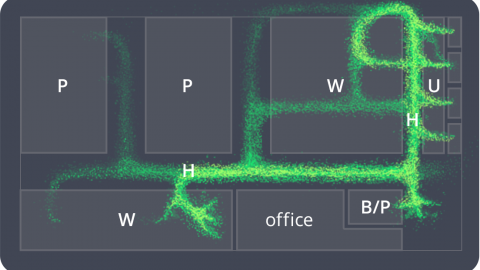
RTLS can help Kaizen in:
3. Maximize Asset Utilization
There are many mobile assets involved in production and intralogistics processes such as forklifts, tugger trains, molds, AGV and primarily people. All of them require Capital expenditure (CapEx) and/or Operating Expenditure (OpEx). The costs quickly add up and are difficult to control as information about their actual usage is difficult to obtain (e.g. forklifts of different manufacturers offer different data). Even if the data can be obtained, it misses location context that provides useful information about “how” the assets were used in addition to the usual “how much.”
By tracking such performance indicators as shift time and time that assets such as forklifts spend in a specific area of a facility, a plant manager can reveal previously unrecognized inefficiencies in routines. For example, forklift tracking projects completed by Indoorway showed that some of them are underutilized, or spent too much time in the areas they shouldn’t, causing production delays.
As a result, production managers can work on solutions to increase their utilization and even eliminate the ones that are not really required, thus reducing costs.
4. Reduce Motion Waste
As our experience shows, detecting fleet traffic bottlenecks and routing inefficiencies within industrial facilities is difficult for managers using Kaizen. A lack of understanding of how the fleet moves is the reason that adds complexity and increases process time.
For example, by tracking your moving assets during shifts, you can detect bottlenecks that cause overtime as well as potential safety issues. For example, one of our recent tracking projects showed that a forklift operator chose to take non-standard routes (marked by RD — Routing Deviations — in Figure 1) and pass through Warehouse (marked by W in Figure 1) with other active equipment.
Since the forklift’s standard route was to move through the Highway (H), it means the decision to pass through the warehouse caused additional safety risks as well as potential process disruptions.
Next, by analyzing analytical reports on movement, a plant manager can understand how the assets like forklifts are moving.
5. Ensure a Consistent Flow of Work-in-Progress (WIP)
Enabling an RTLS to track WIP during manufacturing is a solution that allows to determine process times. For example, by attaching small location tags to fixtures, specialized tools, carts, and other equipment, a factory manager can:
Bottom line: real-time tracking allows the management to realize that a process can be improved upon, and help to understand what could be done to support Kaizen.
Visualization of waste in manufacturing with an RTLS is a suitable solution in this case because of the ability to provide analytical data on the activity and efficiency of assets and entire processes.
Source: Indoorway